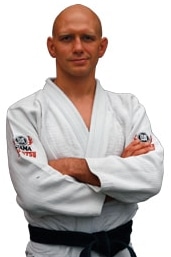
Have you ever grappled with a high-level wrestler and been frustrated by their uncanny sense of balance? You might be trying to use a guard sweep and just about have them swept over. Suddenly – pop – they somehow manage to end up back on top and driving into you again.
A training partner of mine who was a national-level wrestler helped provide one piece of this puzzle. “I always have 3 points of balance when I’m in someone’s guard: two points of contact on the ground with my legs, and a third where my weight is on his body”. I have since played with this concept, and call it “wrestler’s base”. Typically it involves keeping your hips low, driving with your legs (knees off the mat), fighting for inside control with the arms and keeping your head on the opponent’s chest or under his chin. This position helps develop the forward driving pressure that wrestlers are so well known for.
Like all tools, wrestler’s base has advantages and disadvantages. It’s main advantages include neutralizing many guard sweeps and making your opponent carry your weight. The main disadvantages include that it may not be the best position to start most guard passes from, and that it the neck and arms may be vulnerable to chokes and armlocks. Know when to use wrestler’s base and know when to switch to another tool in your toolbox.
In addition to takedowns and control techniques, wrestling encourages the development of strength, balance, aggression and gymnastic athleticism. These attributes are desirable in any grappling context, and we should all try a little harder to cultivate them.
Here are some related resources that will absolutely be useful dealing with that big ex-wrestler who doesn’t know the meaning of ‘half speed’ and turns every friendly rolling session into a fight for survival by using his strength and athleticism:


